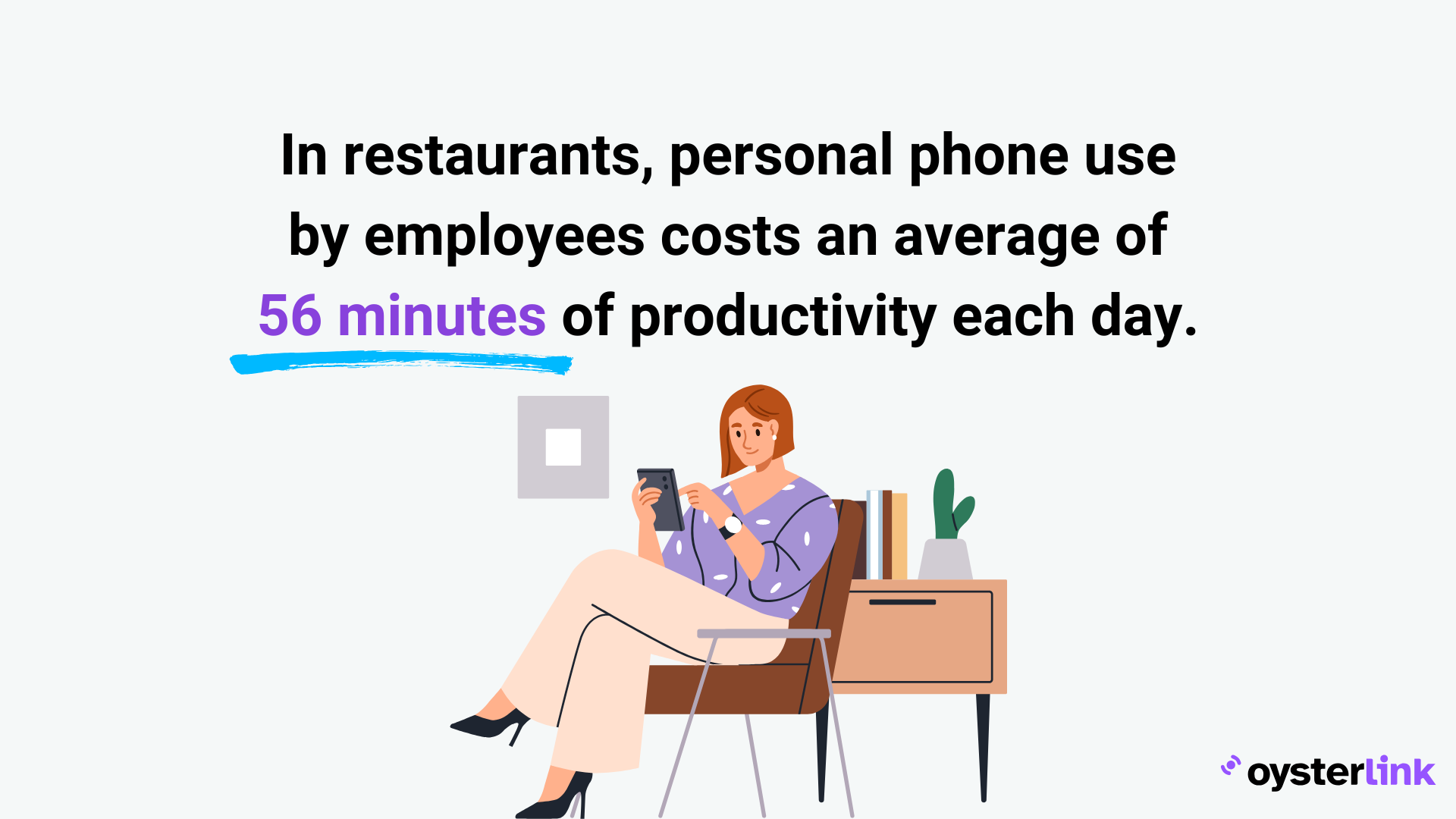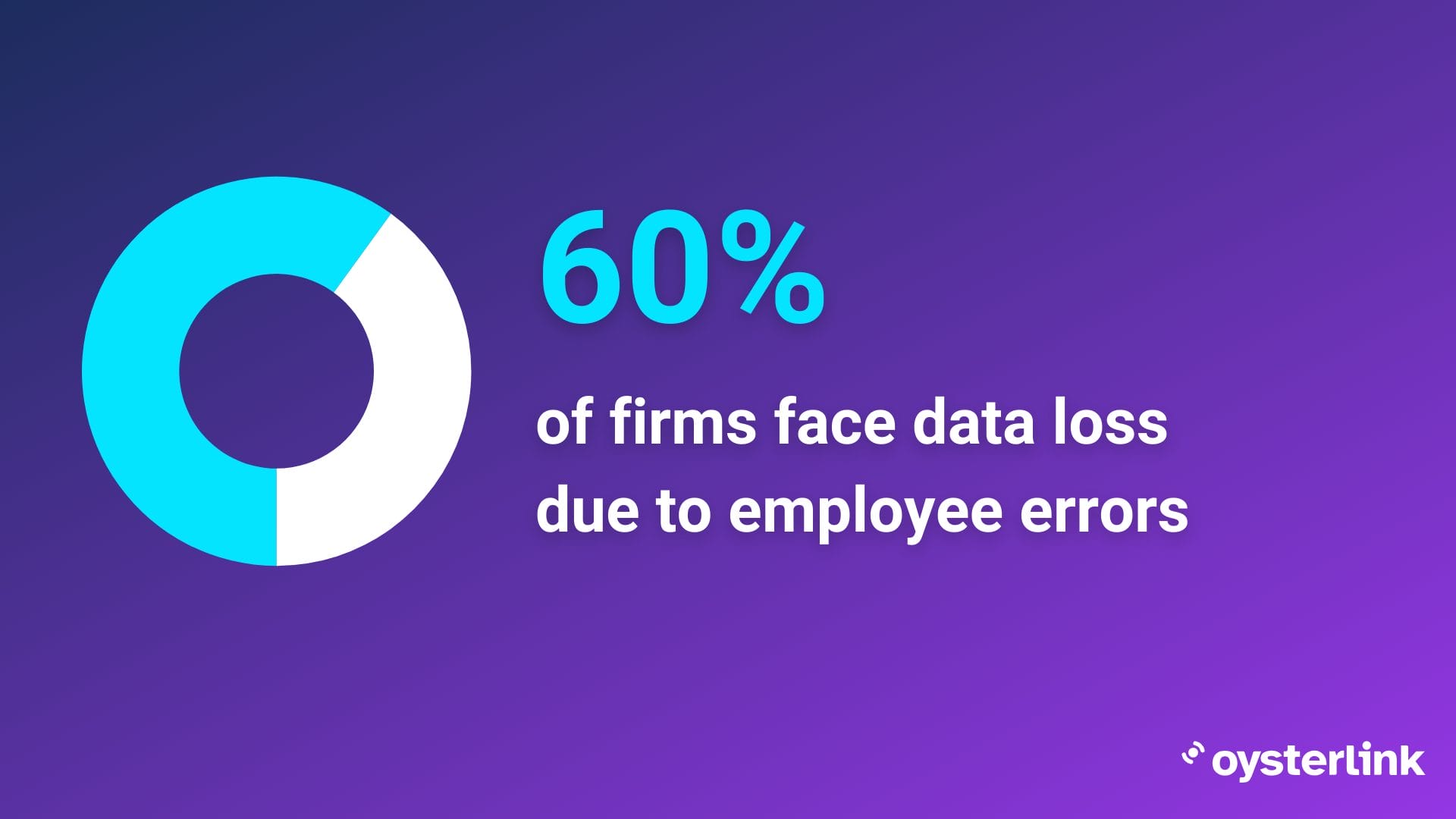Cell phones dominate today’s workplace. About 90% of U.S. workers use their devices for personal matters during work hours. This habit costs businesses around 1.5 hours of employee productivity each day, and phones have become the biggest source of workplace distractions at 55%.
Your business needs a solid employee cell phone policy template — and with good reason, too. A well-laid-out cell phone policy template at work will protect sensitive information and help you retain control.
In this article, we’ll help you create a policy that works for your company’s specific needs while taking an all-encompassing approach to device usage.
The Basics of Employee Cell Phone Policies
A business needs to understand the basic elements that make up an effective employee cell phone policy. These elements help shape how people work and how much they get done.
Why your business needs a cell phone policy
Your employees bring their personal phones to work. This creates both opportunities and challenges for your business. Phones can improve productivity by giving digital access to work tools. However, they can also distract people and affect your profits. In fact, personal phone use costs 56 minutes of productivity daily.
Research shows that cell phones are the primary source of workplace disruptions. Many employees spend too much time on personal calls and messages. On top of being an unproductive habit, uncontrolled phone use can also create safety risks and liability issues. This becomes even more critical when employees operate vehicles or machinery.

Key objectives for employee cell phone policies
Your cell phone policy template should target these main objectives:
- Set clear guidelines for acceptable phone use
- Protect company’s information and prevent security breaches
- Maintain workplace safety standards
- Improve productivity by cutting down on distractions
A well-laid-out policy helps your business benefit from controlled phone use while reducing risks. It also sets the same expectations for all departments and positions.
Common policy challenges to address
The biggest problem you’ll face is finding the sweet spot between access and limits. Many employers don’t deal very well with this because they want workers available outside regular hours.
Consistent enforcement poses another challenge. Your policy must have clear penalties for violations. These need to apply fairly to everyone in the organization. If not, you risk creating bad feelings among staff who see others break rules without consequences.
You can beat these challenges by creating guidelines that work for both business needs and real-life situations. To cite an instance, you might create specific areas for phone use or develop clear steps for emergencies.
Employee Cell Phone Policy Template (Free Download)
Below is a sample employee cell phone policy template that you can download as a Word or PDF file.
Employee Cell Phone Policy
Purpose
This policy is designed to balance access to cell phones for personal use with the need to maintain productivity and fairness in the workplace.
Guidelines for Phone Use
- Personal Phone Use:
- Employees may use personal cell phones during designated breaks and in specific areas, such as the staff breakroom.
- Personal phone use during working hours is prohibited unless pre-approved by management for urgent situations.
- Company-Issued Devices:
- Company-issued phones are strictly for work purposes and must follow all security protocols.
- Personal use of company devices is not permitted unless explicitly stated in your role agreement.
- Emergency Situations:
- In case of emergencies, employees are allowed to use personal phones at their workstation, provided they notify their manager.
Consequences for Policy Violations
- First violation: Verbal warning and documentation in the employee’s file.
- Second violation: Written warning with a performance improvement plan.
- Third violation: Possible suspension or termination, depending on the severity of the violation.
Consistent Enforcement
This policy applies to all employees equally, regardless of role or seniority. Managers are responsible for ensuring fair enforcement and addressing violations promptly.
Building Your No-Cell-Phone Policy Framework
A successful employee cell phone policy template starts with input from the core team of managers, HR personnel and IT staff. This shared approach will give a complete picture of workplace phone use.
Identifying critical policy elements
Your cell phone policy must define acceptable usage parameters clearly. The boundaries for work-related and personal phone use need clear definition. Guidelines for company-provided devices deserve extra attention because they need additional security measures.
Different workplace scenarios need specific protocols, from customer interactions to emergency situations. Each department and job role might need unique requirements based on employee responsibilities.
Structuring policy guidelines
A clear purpose statement explains the policy’s existence. The scope outlines who falls under this policy — full-time employees, part-time staff and contractors.
Your guidelines should cover these areas:
- Security protocols and data protection measures
- Acceptable use during breaks and lunch hours
- Emergency communication procedures
- Storage requirements for personal devices
Setting enforcement parameters
The policy enforcement system should treat all employees equally. Policy violations should line up with your company’s progressive discipline procedures. These start with verbal warnings and get stricter as needed.
Policy discussions and violation records need proper documentation. Notwithstanding that, your approach needs flexibility. Strict enforcement might create resentment among employees and could backfire.
Customizing Policy Rules and Exceptions
Your workplace needs a cell phone policy template that works for everyone. The right guidelines will boost productivity and meet all communication needs.
Department-specific guidelines
Different departments need different rules for phone use. You should set up specific guidelines for:
- Customer-facing roles like Service Staff
- Technical positions that need constant system monitoring
- Management roles with vital decision-making duties
- Remote workers who depend on mobile connections
Start by finding job roles that need constant connectivity and shape your policy to fit them. Then, look at how people communicate in your organization to figure out which positions need more freedom with phone access.
| Position | Reason for Flexibility | Guideline Suggestion |
|---|---|---|
| Management staff | Responsible for communicating with vendors, corporate offices and staff outside of work hours | Allow phone use for work-related communication but limit personal use during peak hours. |
| Technical support | May need phones for system monitoring, troubleshooting or contacting vendors for repairs | Permit phone use as needed for technical tasks but require logging of work-related usage. |
| Delivery drivers | Reliant on mobile devices for navigation, order updates and customer communication | Phones should only be used for job-related purposes while ensuring safety (e.g., no texting while driving). |
| Catering staff | Might need phones to coordinate with event hosts or communicate logistics with the home restaurant | Phones can be used for work tasks but should remain discreet during events. |
| Reservation managers | Often required to manage digital reservation systems or communicate with customers | Limit use to tasks directly related to reservations or seating management. |
| Remote staff | Staff like on-call Chefs or virtual assistants might require phone access to stay updated on scheduling or emergencies | Allow flexible use for work-related updates but monitor usage to prevent over-reliance on personal devices. |
Emergency use protocols
Clear emergency protocols keep your workplace safe. Even with strict no-phone rules, you need reliable ways to communicate during emergencies. Set up multiple communication channels so everyone at risk gets the message.
Write clear rules about phone use during emergencies. Your policy should list backup communication methods like emergency phone lines or intercom systems.
Special circumstance considerations
Your policy should bend when needed. Some staff members might need exceptions to monitor health issues or handle family care duties. While rules should stay consistent, some situations call for adjustments.
Talk to your core team in HR and IT to make sure these exceptions match company goals. Keep records of all approved exceptions and tell everyone about them. This helps avoid confusion and prevents any feelings of favoritism among your staff.
Ensuring Policy Success and Compliance
The success of your employee cell phone policy relies on implementation and maintenance. You need to create clear communication channels and set up consistent monitoring procedures.
Communication strategies
Start your policy implementation with clear communication to all stakeholders. Research shows that regular communication and transparency are the foundations of a healthy work environment and protect company assets.
Give your policy in written form and ask employees to acknowledge it in writing. Without doubt, this protects your business interests and creates a clear record of policy distribution.
Monitoring and documentation
Set up safeguards and training to stop unauthorized access to employee activity logs and surveillance. Store all records in a secure location that only authorized personnel can access. Make sure you maintain a detailed log of anyone who views these records.
Think over privacy expectations when you monitor company-issued devices. Let employees know they should not expect privacy when using company equipment. Your monitoring practices must comply with federal and state laws, especially when you have personal device usage.
To ensure the security and integrity of employee activity logs and surveillance systems, it’s critical to implement robust safeguards and training. With approximately 60% of firms experiencing data loss caused by employee mistakes, the need for secure documentation practices has never been greater.

Progressive discipline procedures
Set up a clear system of progressive discipline for policy violations. Your approach needs these steps:
- Verbal warning with documented discussion
- Written warning detailing specific violations
- Final written warning with an improvement plan
- Termination if the behavior persists
Document each step fully with dates, specific incidents and agreed-upon corrective actions. Note that some violations might lead to immediate termination, especially those with security breaches or safety risks.
Stay consistent with enforcement on all levels of your organization. This creates a fair environment and reduces potential conflicts from unequal policy application.
Conclusion
A solid cell phone policy requires time to develop, but the benefits easily outweigh the original work involved. Your well-laid-out policy should protect business interests and respect what employees need.
The key to success lies in balancing restrictions with flexibility. Clear boundaries in your policy must coexist with enough adaptability to handle workplace scenarios of all types. The rules matter just as much as how you enforce them consistently.
Simple guidelines serve as your starting point, which you can then fine-tune based on company needs and staff input. Your rules will stay current through regular reviews as technology and workplace practices evolve. The core team needs clear communication about what you expect and any policy changes.
A carefully designed cell phone policy does more than boost productivity — it builds a safer, more focused workplace where everyone knows their role. You’ll create a lasting framework that serves your business well through clear guidelines, fair enforcement and proper documentation.
Looking to hire for your hospitality business?
Post Jobs for FreeWant to apply for top paid jobs?
Find Jobs HereEmployee Cell Phone Policy Template FAQs
Start by being clear about what’s okay and not okay for phone use during work hours. Add rules for company devices, security steps, and what happens if someone breaks the rules. Get input from your team and make sure the policy fits your company’s needs without being too strict.
A good policy covers acceptable use, emergency guidelines, rules for work devices and ways to protect sensitive info. It should also address productivity, explain enforcement and set clear expectations. The goal is to balance limiting distractions with allowing important communication.
Think about what makes sense for each role. For example, customer-facing staff — like the Hosts/Hostesses, Servers and Food Runners — might need stricter rules, while tech teams may need more flexibility. Create guidelines tailored to each department’s needs while keeping things fair and productive overall.
Use a step-by-step approach: Start with a verbal warning, followed by a written warning and then a final written notice with an improvement plan.
For repeated or serious violations (like security breaches), termination might be necessary. Be consistent across the board.
Review it regularly — at least once a year or when big changes happen in your business or tech. This keeps it relevant and lets you address feedback or new challenges as they come up.

Written by Lidija Misic
Lidija holds a BA in English Language and has lived in five different countries, where she has worked in various roles, including as a flight attendant, teacher, writer and recruiter. Her biggest passion is crafting great content and reading. She is particularly passionate about creating punchy copy that inspires people to make positive changes in their lives.

Reviewed by Marcy Miniano
Marcy is an editor and writer with a background in public relations and brand marketing. Throughout her nearly decade-long career, she has honed her skills in crafting content and helping build brands across various industries — including restaurant and hospitality, travel, tech, fashion and entertainment.




